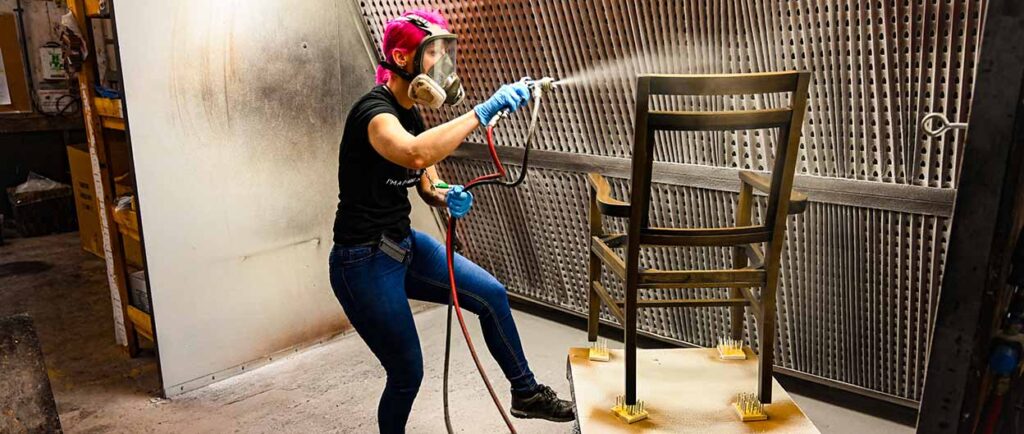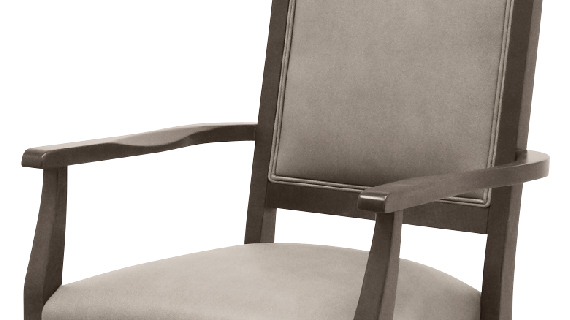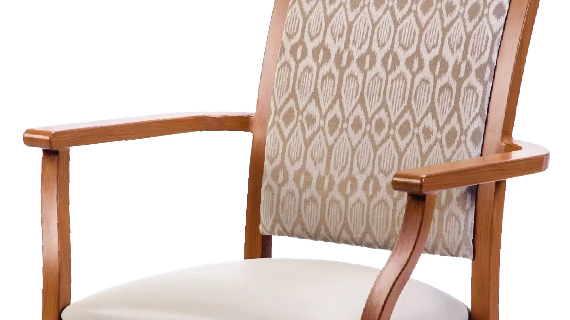Commercial properties need seating that balances beauty, comfort, and practicality. This is true whether it’s a hotel, restaurant, event center, or senior living facility. One of the most common questions we hear is: What’s the difference between real wood and faux wood chairs, and what are the advantages of each?
Price differences between faux wood and wooden chairs vary, although hardwood chairs tend to be slightly more expensive than faux wood. Many people assume that real wood chairs will be much more expensive, but that’s not always the case. Design choices, such as custom fabrics and wood finishes, are often responsible for bigger price differences than frame material alone. The bottom line is that if you really want hardwood chairs, you will be able to find them in your price range.

Other determining factors between these types of commercial chairs are durability, climate performance, maintenance, and design flexibility. Let’s explore how the two materials compare and help you decide which is best for your space.
What Is a Hardwood Chair?
High-quality hardwood chairs are crafted from strong, natural woods such as European beechwood, oak, teak, or walnut. These materials are known for their beauty, strength, and ability to accept rich stains and finishes.
Residential wooden chairs are often made with soft wood, such as maple, pine, spruce, or fir. These types of wood are suitable for light household use but won’t hold up to the demands of commercial use.
Holsag by MityLite hardwood chairs are made in North America using 100% sustainably harvested European beechwood. Each chair is hand-sanded, hand-stained, and finished with a durable catalyzed lacquer that resists cracking and chipping. Holsag chairs feature mortise-and-tenon joints for lasting stability and an industry-leading 10-year warranty.
Advantages of Hardwood Chairs
- Long-lasting with proper care
- Elegant, timeless appearance
- Warm to the touch in cool climates
- Endless customization options
- Can be refinished to look like new after years of use
Cons of Hardwood Chairs
- Heavier than faux wood; not ideal for quick reconfiguration
- Can be damaged permanently by humidity or water
- Generally, they do not stack for storage
- Can be damaged by sanitizers and chemical cleaners
- Require occasional maintenance or refinishing

Because of their natural warmth and luxurious appeal, hardwood chairs are ideal for front-of-house areas like lobbies, waiting rooms, and restaurant dining areas. Hardwood chairs are also recommended for hotel rooms, offices, and other places where the furniture won’t be moved around very often.
On the downside, hardwood chairs are usually heavy for their size and difficult to move around, making them less desirable for spaces that need to be rearranged frequently. If you are looking for event chairs, for instance, wood chairs will be heavier and will store less compactly than typical banquet chairs made with faux wood or metal chair frames. Real wood chairs are also susceptible to deep scratches and dents if not cared for properly.
Another disadvantage of wood furniture is that it can be damaged in humid or moist environments, by sea salt spray, and by chemical cleaners. If furniture will be subjected to frequent spills or harsh cleansers, faux wood chairs might be a better choice. Restaurants in humid climates can install dehumidifiers to help protect wood furniture, if that is the option chosen.
What Is a Faux Wood Chair?
Faux wood chairs are generally made from aluminum or steel frames coated with a faux wood finish. Holsag by MityLite builds faux wood chairs with 100% aluminum frames that are powder-coated and baked, giving them a faux wood grain finish. This creates a similar look and texture of real wood with the strength of metal.
Faux wood furniture can also be made from powder-coated steel, recycled wood chips, or PVC plastic composites.
Pros of Faux Wood Chairs
- Durable (if properly cared for)
- Lightweight and easy to move around
- Can be stacked (depending on the model)
- Resistant to dents, moisture, and temperature changes
- Less expensive than hardwood
- Easy to sanitize (generally not damaged by chemical cleaners)
Cons of Faux Wood Chairs
- Shorter lifespan than hardwood chairs
- Limited customization for frame finishes
- Can’t be refinished
- Susceptible to small surface scratches
- Can feel cold to the touch in winter
Faux wood chairs are excellent for banquet halls, restaurants, event spaces, and humid environments where durability and easy maintenance are top priorities. Since they’re so easy to sanitize, faux wood chairs are also popular in medical waiting areas.
Side-by-Side Comparison: Real Wood vs. Faux Wood Chairs from Holsag by MityLite
Choosing the Right Chair Material for Your Property
The choice between wood or faux wood chairs depends on property needs, usage, climate, budget, and aesthetic goals.
Here’s a quick guide to help narrow down the pros and cons.
When to choose hardwood chairs
- You want a warm, classic aesthetic
- Your climate is temperate or cool
- Furniture won’t be moved around during normal days
- You value natural, sustainable materials
- You’d like unlimited stain and finish options
When to choose faux wood chairs
- Your space experiences high humidity or temperature changes
- You need lightweight, stackable seating
- You want easy maintenance and cleaning
- You require fast setup and teardown flexibility
- You prefer durable, scratch-resistant furniture

Environmental Considerations
Both hardwood and faux wood can be eco-conscious options when made responsibly. Holsag hardwood chairs are built using sustainably harvested wood from FSC® Certified forests, which means that the forests’ new growth exceeds harvesting. Holsag by MityLite Faux wood chairs are made from 100% recyclable aluminum, which supports sustainability by reducing waste and extending product lifespan.
The Final Verdict
There’s no one-size-fits-all answer to the question of which chair material is best for commercial areas. Both hardwood and faux wood chairs offer long-term value, durability, and style. Faux wood tends to be less expensive, while hardwood may last for decades. Your design decision depends on your property’s needs, your local climate, and your priorities for customization and convenience.
- Choose hardwood for a timeless style and natural warmth.
- Choose faux wood for its flexibility, moisture resistance, and lighter weight.
Whichever you choose, Holsag offers expertly crafted options built for beauty, strength, and lasting comfort.
Frequently Asked Questions
Which lasts longer: faux wood or real wood chairs?
Although both types of chairs can last for 10 years or longer, wood chairs last longer.
- Hardwood chairs can be refinished and maintained indefinitely, making them a potentially lifetime investment. The only caveat to this is that real wood chairs need occasional polishing or refinishing, and wood may not last well in humid environments.
- Faux wood chairs with a powder-coated aluminum frame are more durable than real wood in humid areas, and the frame can resist damage for many years. However, faux wood frames may eventually scratch. Faux wood chairs can’t be refinished. Both types of chairs may have upholstery that will need replacing over time.
Is faux wood recyclable?
Yes. Holsag faux wood chairs are made from 100% recyclable aluminum.
Which is better for humid climates?
Faux wood performs better in humidity, since it won’t warp or swell. In addition, faux wood furniture doesn’t attract insects like termites, beetles, or ants.
Which type of chair is more comfortable?
Hardwood feels warmer to the touch, which is preferable in cold climates. Faux wood feels cooler, which can be refreshing in warm weather climates. This is because wood doesn’t conduct heat as well as metal. Metal frames like aluminum are efficient conductors. A metal surface will pull heat away from a person’s body, leaving a lingering feeling of coolness. This could be an advantage in hot climates. But, on a cold winter day, faux wood furniture can feel uncomfortably cold.
Which offers more design flexibility?
Hardwood chairs offer more custom options. Natural wood accepts any stain or finish, while faux wood has limited color variations. Both hardwood and faux wood chairs with upholstery are available in a wide variety of standard and custom fabrics, including C.O.M. (Customer’s Own Material).



